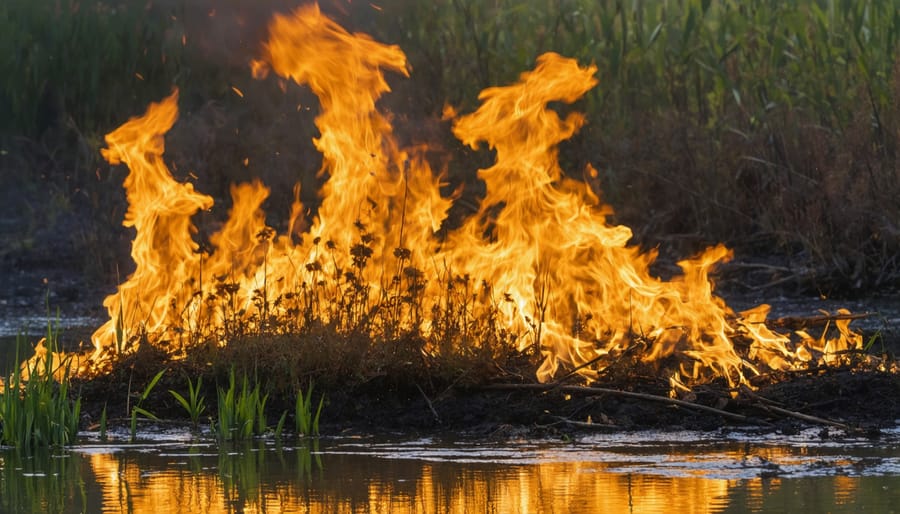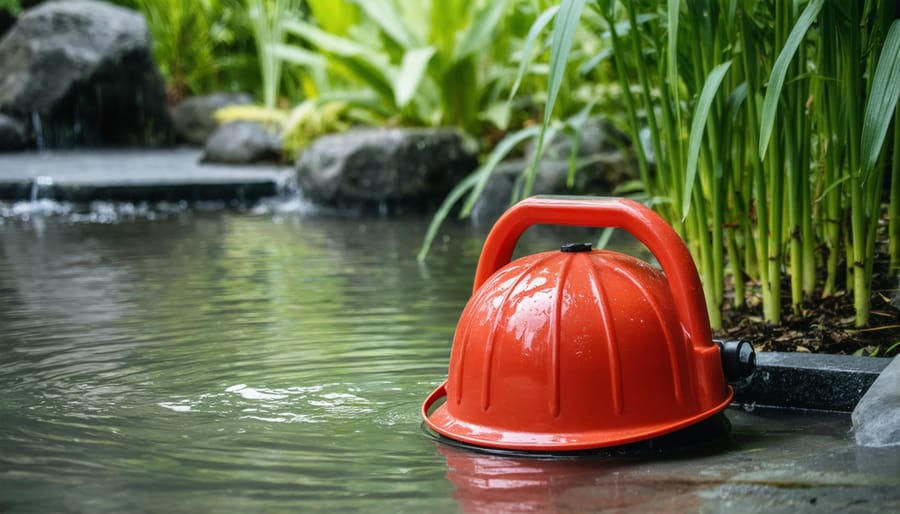
Why Your Water Garden Needs a Fire Watch (Even Near All That Water)
A fire watch is a designated person who monitors an area for fire hazards during and after hot work activities like welding, cutting, or grinding—even around your peaceful water garden. If you’re installing metal edging, soldering copper fountain components, or hiring contractors to work near your pond, understanding fire watch requirements protects your landscape investment and keeps your family safe.
Most water gardeners never consider fire risks until a contractor mentions needing a “fire watch” during pond construction. The term sounds official and confusing, but it’s surprisingly straightforward: someone stays alert for sparks, embers, and smoke while monitoring the work area for at least 30 minutes after hot work stops. This simple safety measure prevents sparks from torches or grinders from igniting nearby mulch, wooden decking, dried vegetation, or decorative grasses surrounding your water feature.
Your pond project might require fire watch when you’re cutting metal reinforcement bars for retaining walls, welding custom steel frames for waterfall features, or using propane torches to shape pond liners. Even though water is your primary element, the materials around your pond—landscaping timbers, synthetic decking, rubber membranes, and seasonal plant debris—create unexpected fire fuel. Building departments often mandate fire watch for permits, and many insurance policies require documented fire safety measures during construction.
Understanding fire watch transforms it from bureaucratic obstacle to practical safety tool, letting you complete your dream water garden project confidently and responsibly.
What Exactly Is a Fire Watch?

The Two Types of Fire Watch You’ll Encounter
When you’re working on your water garden project, you’ll likely encounter two main types of fire watch, and knowing the difference can save you time and confusion.
**Construction or Hot Work Fire Watch** is the most common type for pond builders. This applies whenever you or your contractor uses welding equipment, propane torches for pond liner installation, cutting tools that create sparks, or gas-powered equipment near combustible materials. Think about it—that propane torch you’re using to smooth pond liner seams or the angle grinder cutting through metal edging creates sparks that could ignite nearby dry grass, wood decking, or landscape fabric. During these activities, someone needs to actively watch for fire hazards, keeping a fire extinguisher handy and monitoring the area for at least 30 minutes after the hot work stops.
**Preventive Fire Watch** happens when your property’s fire protection systems aren’t working properly. If you’re doing major renovations that temporarily disable smoke detectors or sprinkler systems near your water feature area, you might need someone to patrol and watch for fire risks until everything’s back online. This type is less common for typical water garden projects but worth understanding if you’re tackling larger outdoor renovations.
When Your Water Garden Project Requires a Fire Watch
Working With Electrical Components Near Your Pond
When you’re installing pumps, adding underwater lights, or upgrading your pond’s electrical systems, fire watch protocols might come into play—especially if you’re using hot work equipment like soldering irons or heat guns near combustible materials. I learned this firsthand when installing my own pond lighting system and needed to splice waterproof connections using a heat shrink tool near wooden decking.
Fire watch becomes necessary when you’re working with electrical components that generate heat in areas where dried vegetation, wooden structures, or stored materials could ignite. This might include heating wire connections, welding metal pond fixtures, or using power tools that spark near mulch beds or dried leaves. Some municipalities require a designated fire watch person (sometimes just a responsible friend or family member) to monitor the work area during and after hot work activities.
Before starting any electrical project around your pond, take basic electrical safety precautions and check if your local regulations require fire watch procedures. Keep a charged fire extinguisher nearby, clear away combustible debris, and have someone monitor the area for at least 30 minutes after completing work. It’s simple vigilance that protects both your beautiful water feature and your property.
Hot Work Around Water Features
If you’re planning to add a waterfall spillway, install metal edging around your pond, or create a stunning metal sculpture as a focal point, you might need hot work—welding, cutting, or torch operations that create sparks and intense heat. Here’s where things get tricky: even though you’re working around water, fire risks are surprisingly real.
Sparks from cutting metal coping can easily land in nearby mulch beds, ornamental grasses, or wooden deck areas surrounding your pond. During one backyard project, I watched a single spark ignite dried leaves fifteen feet away from the welding site—talk about an eye-opener! Your fire watch person monitors these flying embers, keeps a charged extinguisher or water hose ready, and stays vigilant even after the work stops, since smoldering can continue unseen for hours. When contractors are modifying structural elements or installing custom features that require hot work, insist on proper fire watch procedures. Your beautiful water garden shouldn’t come with unexpected fire damage to your landscaping or home.
Nearby Construction and Landscape Changes
Planning to expand your patio next to your koi pond or build that dream deck overlooking your water feature? These exciting projects might require a fire watch, even though they seem unrelated to fire hazards. When contractors use torches for welding, hot tar for roofing, or heat guns for various installations near your water garden, there’s potential for sparks to ignite nearby mulch, wooden structures, or dry vegetation.
I learned this firsthand when adding a pergola beside my pond. The contractor mentioned needing someone to monitor for two hours after finishing the metalwork each day. That’s fire watch—keeping an eye out for smoldering embers that could flare up long after the work stops. Your local building department typically determines if your renovation requires this precaution based on the work type and proximity to combustible materials. Many homeowners don’t realize their beautiful bamboo screening or cedar deck boards can become fire concerns during construction involving heat or flames.
The Hidden Fire Hazards Around Water Gardens
Dry Plant Material and Seasonal Debris
Here’s a reality check that surprises most water gardeners: your beautiful pond can be surrounded by serious fire hazards! Dead reeds standing at the water’s edge might look picturally rustic, but they’re essentially nature’s kindling. Those golden-brown stalks dry out completely and ignite easily, especially during hot summer months.
I learned this the hard way when a neighbor’s sparkler landed near my dried cattails during a Fourth of July gathering. Thankfully, nothing caught fire, but it was a wake-up call! Fallen leaves that accumulate around pond borders create dense layers of tinder-dry fuel. Ornamental grasses you planted for texture? They’re gorgeous until they die back and become crispy fire starters.
Even marsh plants that grow partially submerged can develop dried-out portions above the waterline. The irony is striking—you’ve got gallons of water right there, yet the surrounding vegetation creates a fire risk that rivals any dry meadow. Regular cleanup of dead plant material isn’t just about aesthetics; it’s essential fire prevention that protects your investment and property.

Wooden Structures and Decking
Many of us love adding wooden bridges, cozy gazebos, or charming boardwalks around our ponds—they’re perfect for enjoying the view and creating that peaceful retreat vibe! But here’s something important: these wooden structures need special attention during any hot work nearby.
Wood is naturally combustible, and when you’re doing welding, torch work, or cutting metal for pond installations, sparks can travel surprisingly far. Even treated lumber can ignite under the right conditions. A fire watch becomes essential when contractors are working within spark range of your deck or seating area—typically within 35 feet.
The good news? Fire watch requirements are straightforward. Someone simply monitors the wooden structures during and after hot work, keeping a fire extinguisher handy and watching for smoldering spots that might not flame up for hours. If you’re DIYing repairs near wooden features, consider having a helper play this role. It’s a simple precaution that protects your investment and keeps your backyard sanctuary safe while you’re making improvements.
Gas Lines and Propane Features
Many water gardeners love extending their outdoor living space with cozy fire features and propane-powered amenities. Fire pits create wonderful ambiance for evening pond-gazing, while propane heaters let you enjoy your water garden well into cooler months. Outdoor kitchens with gas grills are perfect for entertaining guests beside your waterfall.
Here’s the catch: anytime you’re working with gas lines or propane installations near your pond, you may need a fire watch. This is especially true during construction or repairs when welding, cutting, or other hot work happens nearby. Even routine maintenance on gas connections can generate sparks or heat that pose temporary fire risks to surrounding landscaping, wooden deck structures, or plant materials around your pond.
If you’re adding these features, check with your local fire marshal about fire watch requirements. It’s a simple step that protects your beloved water garden investment while you create the perfect outdoor entertaining oasis.
Chemical Storage and Equipment Sheds
If you keep pond treatments, algaecides, fertilizers, or gasoline for pumps and equipment in a shed near your water feature, you’ve got a potential fire concern. These chemicals and fuels are flammable, and when you’re doing any hot work—like welding metal edging or using cutting torches on fountain components—sparks can easily travel. A fire watch becomes necessary when your project happens within range of these storage areas. Even something as simple as grinding metal near your equipment shed requires someone keeping an eye out for smoldering materials or stray sparks that could ignite stored supplies.
How to Conduct Your Own Fire Watch
Setting Up Your Monitoring Area
Setting up your monitoring area starts with walking the perimeter of your work zone—think of it like establishing the boundaries of a new garden bed, but for safety. Mark a clear 30-foot radius around any hot work like welding or torch cutting on pond features. This gives you space to spot stray sparks before they reach dried leaves, mulch, or nearby structures.
Position yourself where you can see the entire work area plus potential escape routes for flying embers. I learned this the hard way when a spark landed behind my pump house during a metal trellis project! Stand upwind when possible, and keep a clear path to your water source or fire extinguisher—never box yourself in.
Focus on monitoring combustible materials: wood decking, overhanging branches, stored supplies, and yes, even that pile of dried pond plant trimmings you’ve been meaning to compost. Your eyes are your best tool here, constantly scanning for smoke, glow, or unusual smells.
Essential Fire Safety Equipment to Keep On Hand
When you’re conducting a fire watch around your water garden project, having the right equipment within arm’s reach can make all the difference. Let’s talk about what you’ll actually need!
First up, keep a properly rated fire extinguisher nearby—preferably an ABC-type that handles multiple fire types. I learned this lesson during a welding project near my koi pond when a spark landed on some dry leaves! You’ll also want multiple water sources ready. While your pond provides one backup, having charged garden hoses with functional nozzles gives you immediate response options.
Communication devices are crucial too. Keep a fully charged mobile phone or two-way radio handy so you can call for help without leaving your post. Don’t forget a reliable flashlight with fresh batteries, especially if your fire watch extends into evening hours.
Other essentials include a sturdy bucket (great for spot dousing), heat-resistant gloves, and a fire blanket for smothering small flames. A basic first aid kit should always be part of your emergency preparedness plan. Store everything in one clearly marked spot—you won’t want to hunt for equipment during an emergency.

What to Watch For During and After Work
During your hot work project, you’ll need to keep your eyes peeled for several telltale warning signs. Watch carefully for any sparks that travel beyond your immediate work area—they’re sneaky and can land in mulch, dry leaves, or wooden deck crevices around your pond. Smoke is your obvious red flag, but don’t just look for billowing clouds. Thin wisps or that distinctive “something’s burning” smell deserve immediate investigation.
Pay special attention to smoldering materials. Unlike dramatic flames, smoldering can be nearly invisible, hiding beneath surfaces or inside porous materials. Check behind rocks, under pond liners, and around any wooden structures where heat might have accumulated. Your fire extinguisher should stay within arm’s reach throughout the entire process.
Here’s what catches many water gardeners off guard: the critical monitoring period doesn’t end when you pack up your tools. Materials can continue smoldering for hours after you’ve finished welding or cutting. Plan to check your work area every 30 minutes for at least three hours after completing hot work. Before calling it a day, do one final thorough inspection, moving materials and checking hidden spots. Think of it as the cool-down lap after your project marathon—absolutely essential for safety.
When to Call in Professional Fire Watch Services
While many fire watch situations around your water garden can be handled with vigilance and common sense, there are times when calling in the professionals isn’t just smart—it’s absolutely necessary.
First, let’s talk permits. If your municipality requires a fire watch as part of your construction or hot work permit, they’ll often specify that you need certified fire watch personnel on site. This isn’t something you can sidestep by appointing your neighbor or family member to keep an eye on things. Building inspectors take these requirements seriously, and using uncertified watchers can result in work stoppages, fines, or even invalidated permits. Always check your permit conditions before starting any project involving welding, cutting, or other fire-risk activities near your pond.
Insurance considerations are equally important. If something goes wrong during a project and you haven’t followed professional fire watch protocols, your homeowner’s insurance might deny your claim. Professional fire watch services document their presence, maintain detailed logs, and carry their own liability coverage—all of which protect you if the unexpected happens.
You should definitely call professionals when dealing with large-scale projects like major pond renovations involving multiple contractors, extended periods of hot work (anything lasting more than a day), or situations where fire suppression systems are temporarily disabled. Professional fire watch personnel are trained in fire behavior, know how to use specialized equipment beyond basic extinguishers, and understand emergency response protocols.
Think of it this way: you wouldn’t hesitate to hire an electrician for complex wiring. The same principle applies when fire safety gets serious. Professional fire watch services might cost a few hundred dollars, but that’s a bargain compared to losing your beautiful water garden—or worse, your home.
Creating a beautiful water garden should be a joyful experience, and understanding fire watch requirements doesn’t need to dampen your enthusiasm—it simply adds another layer of protection to your outdoor haven. Whether you’re planning a welding project for custom pond edging, using hot work to install decorative features, or working near dry vegetation during pond construction, knowing when a fire watch is necessary helps you protect both your investment and your home. Remember, a fire watch is essentially having a trained observer monitor your work area during and after hot work operations, typically for at least 30 minutes. It’s a straightforward precaution that can prevent devastating consequences.
The key scenarios we’ve covered—welding near combustibles, working during dry seasons, and using heat-producing equipment—are all manageable with proper planning. By incorporating fire watch awareness into your comprehensive water garden safety approach, you’re demonstrating the responsible stewardship that makes our hobby so rewarding. Take these simple precautions seriously, keep your fire extinguisher handy, and you’ll create stunning water features with complete peace of mind.
